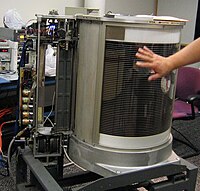
Photo from wikipedia
Surface-modified graphite (acid-treated expanded graphite (AEG)/base-etched graphite (BEG)) displays an abundant micro- to nano-sized pores/defects and exposed edge graphitic site. AEG and BEG exhibit high specific capacity, rate capability and… Click to show full abstract
Surface-modified graphite (acid-treated expanded graphite (AEG)/base-etched graphite (BEG)) displays an abundant micro- to nano-sized pores/defects and exposed edge graphitic site. AEG and BEG exhibit high specific capacity, rate capability and cyclic stability compared with pristine graphite. High defect density of BEG electrode exhibits profound effect on the chloroaluminate anions intercalation kinetics. Rechargeable aluminum-ion batteries (AIBs) are a new generation of low-cost and large-scale electrical energy storage systems. However, AIBs suffer from a lack of reliable cathode materials with insufficient intercalation sites, poor ion-conducting channels, and poor diffusion dynamics of large chloroaluminate anions (AlCl 4 − and Al 2 Cl 7 − ). To address these issues, surface-modified graphitic carbon materials [i.e., acid-treated expanded graphite (AEG) and base-etched graphite (BEG)] are developed as novel cathode materials for ultra-fast chargeable AIBs. AEG has more turbostratically ordered structure covered with abundant micro- to nano-sized pores on the surface structure and expanded interlayer distance ( d 002 = 0.3371 nm) realized by surface treatment of pristine graphite with acidic media, which can be accelerated the diffusion dynamics and efficient AlCl 4 − ions (de)-intercalation kinetics. The AIB system employing AEG exhibits a specific capacity of 88.6 mAh g −1 (4 A g −1 ) and ~ 80 mAh g −1 at an ultra-high current rate of 10 A g −1 (~ 99.1% over 10,000 cycles). BEG treated with KOH solution possesses the turbostratically disordered structure with high density of defective sites and largely expanded d -spacing ( d 002 = 0.3384 nm) for attracting and uptaking more AlCl 4 − ions with relatively shorter penetration depth. Impressively, the AIB system based on the BEG cathode delivers a high specific capacity of 110 mAh g −1 (4 A g −1 ) and ~ 91 mAh g −1 (~ 99.9% over 10,000 cycles at 10 A g −1 ). Moreover, the BEG cell has high energy and power densities of 247 Wh kg −1 and 44.5 kW kg −1 . This performance is one of the best among the AIB graphitic carbon materials reported for chloroaluminate anions storage performance. This finding provides great significance for the further development of rechargeable AIBs with high energy, high power density, and exceptionally long life.
Journal Title: Nano-Micro Letters
Year Published: 2021
Link to full text (if available)
Share on Social Media: Sign Up to like & get
recommendations!